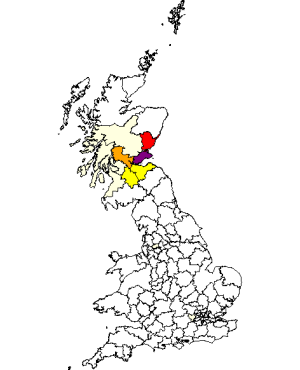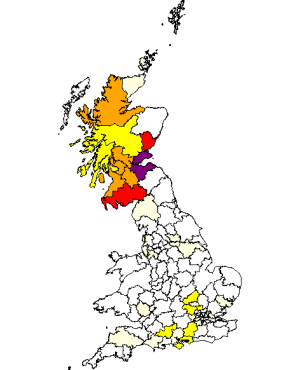The Masterton Surname
MASTERTON. King Malcolm IV (1153 - 1165) granted the lands of Ledmacdunegil (Ledmacduuegil or Lethmachduuegil) afterwards called Masterton as formerly held by Magister (=Master) Ailricus, cementarius, to the Abbey church of Dunfermline (RD., p.21,30,42). This Ailricus may be the magister or 'master' after whom the lands took their later name. The first appearance of the surname is in 1296 when William de Mastertone or de Meystertone of the county of Fife rendered homage for his possessions. His seal bears a lion rampant, a rose in front, and S' Will'i de Maistertvn (Bain, II, p.188, 201). Duncan de Maysterton witnessed the homage of Duncan, earl of Fife to the abbot of Dunfermline in 1316 (RD., p.235,236), Symon de Maysterton, rector, was a witness in 1357 (Newbotle p.309), and Sir Thomas Masterton was a canon regular of Cambuskenneth in 1476 (SBR., p.261). The Mastertons were a family of note in the Dunfermline district before the Reformation, and their genealogy, by Victor A. Noël Paton, is published in the Miscellany of the Scottish History Society (I, p. 457-466). Maistertoun 1617, Maistertoune 1642, Maistertown 1550, Maystirtoun 1434.
The Surnames of Scotland
Their Origin, Meaning and History
George F. Black, Ph.D.
The New York Public Library 1962
page 586
MASTOURSTOUN. An old family taking their surname from the lands of Masterton, near Dunfermline. The writer, in 1878, communicated a notice of them to the 'Miscellanea Genealogica et Heraldica' which was also printed for private circulation.
Hugo de Villa Magistri is a witness to a charter, c.1250; his son, William de Meistreton, of the county of Fife, swore fealty to Edward I. 1296 and sealed with a lion rampant. Their descendants held Masterton till the sixteenth century.
Soon after the Reformation, Alexander, probably a descendant of Masterton of that Ilk, had a feu-charter of part of Grange; in 1763 [ed. - should be 1673] Adam Masterton of Grange registered - argent, a chevron between two crescents in chief and a mullet in base gules, on a chief azure an eagle displayed or.
Alexander Masterton acquired Parkmill, co. Clackmannan, 1547, and his representative, Francis of that place, registered arms 1672-78 - argent, a chevron gules and a chief azure.
The seal of Robert Masterton of Bad, 1588, is an eagle displayed impaling a chevron with a crescent in chief or on a chief.
Other variations occur in the MSS.
Scottish Arms,
being a collection of armorial bearings AD 1370 - 1678
R. R. Stodart
Edinburgh 1881
Vol. II p 267 ill.p.146
MASTERTOWN [Dunfermline parish] Settlement; National Grid Ref NT121849; (accurate); OS Pathfinder Sheet 394; Elevation 70 metres; South West Facing
Maistertun 1200 x 1225 RRS i no. 112 [=Dunf. Reg. no. 39; written above Ledmacduuegil in the phrase 'sicuti Magister Ailricus cementarius ('mason') illam tenuit'; in a hand contemporary with that of the main text (see RRS i no 112 note and Dunf. Reg. p. xix).]
(Hugh de) villa magistri 1225 x 1235 Dunf. Reg. no. 171 [dates approximate]
(William de) Maistertun c.1225 x 1231 Dunf. Reg. no. 174
usque ad diusas de Maistertun 1230 x 1240 Dunf. Reg. no. 198 [as far as the marches of Mastertown]
(William de) Maistertun 1230 x 1240 Dunf. Reg. no. 198
(William de) Maystertun 1272 Dunf. Reg. no. 319
(William de) Maistertun 1278 Dunf. Reg. no. 86
(William de) Meistreton 1296 Inst. Pub.
(Duncan de) Maystertona 1316 Dunf. Reg. no. 348
(John Dauisone de) Mastirtone 1491 Dunf. Recs. {27}
Masterton 1535 Dunf. Reg. Court Bk. 125 [Patrick Robertson and Robert Kent in Masterton]
Maistertoun 1563 RMS iv no. 1476
Maistertoun 1626 Retours (Fife) no. 382
Maisterton 1642 Gordon MS Fife
Mastertoun 1654 Blaeu (Pont) West Fife
Maistertoun 1654 Blaeu (Gordon) Fife
Mastertown 1753 Roy sheet 17,5
Mastertown 1775 Ainslie/Fife
Scots maister 'master' + Scots toun.
'The estate of the master'. The eponymous master is Master Ailric the mason, fl. before 1153, presumably one of those in charge of building work at Dunfermline Abbey. As is clear from RRS i no. 112, it was called Ledmacduuegil or Ledmacdunegil (see below) before it acquired the name by which we know it today, and it serves as a reminder that names containing the generic toun do not necessarily mean new settlement on land previously unoccupied or unfarmed. It was given to Dunfermline Abbey by King Malcolm IV on the day of David I's funeral (24 May 1153) (RRS i no. 118).
It was known as Maistertun already in the first half of the thirteenth century, as this is written above Ledmacduuegil in RRS 1 no. 112 in a hand of that period (see RRS i no. 112 note and Dunf. Reg. p. xix). Furthermore, in the early thirteenth century William of Maistertun witnesses Dunf. Reg. nos. 174 and 198.
As this name's specific is a common noun whose meaning has been transparent since its coining in the late twelfth century, it has been particularly prone to translation. One of the witnesses to an early thirteenth-century charter (Dunf. Reg. no. 171), along with several other Fife land-holders, is one 'Hug[o] de villa mag[ist]ri', while in Instr. Pub. of 1296, the first element has been translated into Old French to give Meistreton.
LETHMACDUNGAL [Dunfermline parish] Settlement; National Grid Ref NT121849; (assumed location); Elevation 70 metres; South West Facing
Ledmacduuegil 1153 x 1156 RRS i no. 112 ['Probably 1153' (see footnote in RRS i, p. 178); = Dunf. Reg. no. 39; sicuti Magister Ailricus cementarius illam tenuit ('as Master Ailric the mason held it')]
Ledmacduuegil 1163 Dunf. Reg. no. 237
Ledmacduuegil 1227 Dunf. Reg. no. 74
Lethmachduuegil 1277 Dunf. Reg. no. 81
Gaelic leth + Gaelic mac + pn Dungal or Dughall1
'Half (-davoch?)' or 'hillside of the sons of Dungal or Dughall. The basic meaning of leth is 'half', but it can also mean 'side'. It was the earlier name of Mastertown, which lies on a very pronounced south-west facing slope.
Note:
1 RRS i no. 112, as well as Dunf. Reg no. 39, reads Ledmacduuegil, which might represent mac Dubhgaill, (modern Gaelic Dughaill) 'sons of Dougal', a personal name which appears twice in early Fife (see Baldougal + SSL). However, 'Dungal' is the more likely reading, since the epenthetic e is more likely to have arisen between n and g (see O'Rahilly 1972, 199). I owe this interpretation to Dr Dauvit Broun. According to O Corrain and Maguire (1990, 80) the name Dungal was one of the most popular names in medieval Ireland. This would be the only occurrence of it in medieval Fife.
Sources:
RRS i Regesta Regum Scottorum vol. i (Acts of Malcolm IV) ed. G.W.S. Barrow, Edinburgh 1960.
Dunf. Reg. Registrum de Dunfermelyn, Bannatyne Club 1842.
Inst. Pub. Instrumenta Publica sive Processus super Fidelitatibus et Homagiis Scotorum Domino Regi Angliae Factis 1291-96, Bannatyne Club 1834 [Ragman Roll].
Dunf. Recs. The Burgh Records of Dunfermline, ed. E. Beveridge (Edinburgh 1917).
Dunf. Reg. Court Bk. Regality of Dunfermline Court Book 1531-1538, ed J.M. Webster and A.A.M. Duncan 1953.
RMS Registrum Magni Sigilli Regum Scottorum ed. J.M. Thomson & others, Edinburgh 1882-1914.
Retours Inquisitionum ad Capellam Domini Regis Retornatarum, quae in publicis archivis Scotiae adhuc servantur, Abbreviatio, ed. T. Thomson (3 vols., 1811-16) vol. 1 Fife and Kinross.
Gordon MS Fife Fyfe Shire MDCXLII - Fife Provincia Noviter Delineata, James Gordon, 1642, NLS (National Library of Scotland). Adv.MS.70.2.10.
Blaeu (Pont) West Fife 'Fifae Pars Occidentalis, The West Part of Fife', Timothy Pont's map of West Fife compiled in the 1590's with minor additions made by Robert or James Gordon, printed in Blaeu 1654.
Blaeu (Gordon) Fife 'Fifae Vicecomitatus, The Sherifdome of Fyfe', James Gordon's map of Fife, completed in 1645, and printed in Blaeu 1654.
Roy 1753 The Military Survey of Scotland, supervised by General William Roy, the 'fair copy', BM. Ref. K. Top XLVIII 25-1b, c; photocopies available in National Library of Scotland (NLS)Edinburgh University, Royal Scottish Geographical Society.
Ainslie/Fife Map of the Counties of Fife and Kinross compiled and engraved by John Ainslie 1775.
The Place-Names of Fife
Volume One. West Fife between Leven And Forth
Simon Taylor with Gilbert Markus.
Shaun Tyas, Donington, 2006
pp 337-8; p 331
Reproduced with permission of the author. Links to maps by permission of National Library of Scotland.
This link is to the National Trust/University College London surname profiler which compares the distribution of surnames in 1881 and 1998. This confirms that even in 1881, Mastertons were most prevalent in Fife. By 1998, Mastertons were more dispersed but still most common in Fife and Lothians. Tasmania is the Australian state with the highest frequency, Otago in New Zealand, and Hawaii in USA.

Distribution of Mastertons in UK in 1881 |

Distribution of Mastertons in UK in 1998 |
Source: www.nationaltrustnames.org.uk